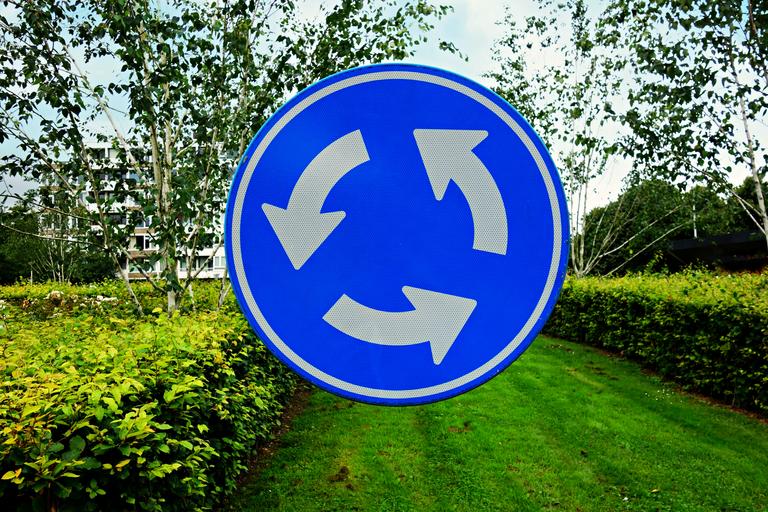
Roundabouts can be in various sizes depending on the available space and age. They are put in place in order to ensure the free flow of traffic and prevent accidents and vehicle collisions in traffic.
Despite the purpose of a roundabout, it is still possible for the flow of traffic to be hindered if drivers do not follow the available information such as; signal posts, etc.
Whether you are driving on a single or multi-lane, you must yield to vehicles already at the roundabout and await an opportunity to enter traffic to get to your exit.
What is Considered a Roundabout?
A roundabout also known as ‘Traffic Circles’ or ‘Rotaries’ in some places is a circular junction or intersection that allows the flow of traffic in a direction around the central island. It is a point in the middle of the road where several roads meet
In a roundabout, you must drive counterclockwise around the center island with preference given to those already at the roundabout. There are usually no traffic stops or signals at roundabouts because drivers are expected to know what to do.
It is a safe option for the free flow of traffic, and pedestrians and also better for vehicles as they have lesser idling time which would have increased fuel consumption and emissions.
At a roundabout, the right of way is given to circulating traffic by those entering the traffic. The size of the roundabout may depend on whether it is old or new, newer roundabout tends to be bigger and wider than old ones.
In a Roundabout You Must Drive In?
Driving in a roundabout may be easy or hard depending on the flow of traffic and whether the roundabout is a single-lane or multi-lane. Therefore, it is important to know how to drive in a roundabout.
Driving in a Single Lane Roundabout
To drive in a single-lane roundabout, you should do the following:
- You will always see a yellow sign ahead when approaching a roundabout. Upon seeing this sign, you should reduce your speed and follow the recommended speed limit in a roundabout.
- Pedestrians will be at the roundabout crosswalk; therefore, you should slow down as you get close to the roundabout.
- As you approach the roundabout and come close to the yield sign with a red and triangular sign, you should look to your left and yield the right of way to traffic already at the roundabout.
- You can proceed to enter the circle and get to your exit once there is an opening to do so. There may be no need to yield if there is no traffic which makes it easy for you to enter the flow.
- You should also use your turn signal when about to exit, be on the lookout for pedestrians and ensure to stick to your lane in the roundabout.
Driving in a Multi-Lane Roundabout
To drive in a multi-lane roundabout, you should do the following:
- On approaching the roundabout, you will see two signs; the yellow roundabout sign and the black and white lane choice sign. The lane choice sign is important because it helps you choose as you enter the roundabout.
- In choosing a lane to enter, if you want to get in the left lane, you should go straight or left. If you want to get in the right lane, you should go straight or right. You can also decide to make a U-turn in the roundabout.
- After deciding on which lane to join and approaching the roundabout, you should watch out for pedestrians in the crosswalk
- Yield to drivers already in the roundabout when you get to the dash yield line. In a multi-lane roundabout, you are expected to yield to both lanes in the traffic.
- At the first sight of a gap in the traffic, you should proceed to enter and emerge in order to get to your exit. Before exiting, you should check for pedestrians and can as well join the flow of traffic if there is no traffic at the roundabout.
What Lane Should I Be On In a Roundabout?
The lane you should be on in a roundabout is largely determined by where your exit is. If you are going halfway around the roundabout, you should be in the left lane. On the other hand, if you are going more than halfway, you should be in the right lane.
For roundabouts with more than two lanes, you should look to the road markings for directions as regards the right lane to be on to get to your exit.
Do You Have to Drive Around a Roundabout?
You do not necessarily have to go around a roundabout to get to your exit, however, this may be necessary if you either missed your exit or get trapped inside the lane.
Driving around the roundabout is the most likely solution in times when you missed your exit or misunderstood the direction signals in the roundabout.
Rather than causing traffic by staying in a spot to figure your way out, go around the roundabout.
How Do You Get Out of a Roundabout?
Getting out of a roundabout is quite easy if you follow all guides and information available to you for driving in a roundabout.
To get out of a roundabout, you should do this;
- If you are taking the exit on the left, you should signal left and follow the left lane to get to the exit. Ensure to maintain the left lane while signaling the left.
- If you are taking the right exit, you should signal right and follow the right lane. Maintain this lane also while still signaling right.
- If there is a need to change lanes, do so.
- If you want to take an intermediate exit, you should choose the appropriate lane when getting close to the exit.
- You may not necessarily need to signal your approach.
- If you have passed the exit before the one you want, signal left.
An important thing to note when getting out of a roundabout is your indicator must be on the whole time while maintaining your lane.
If you are exiting from the left lane, maintain the left lane till you get to your exit and if you’re exiting from the right lane, maintain the right lane till you get to your exit.
If there is a need to change or you get stuck in between lanes, you may need to go around the roundabout to get on the right lane.
Conclusion
Getting in and out of a roundabout is very easy if you will follow the available information. Also, bear in mind if you are approaching a multi-lane roundabout that you are expected to choose a lane as you approach.









